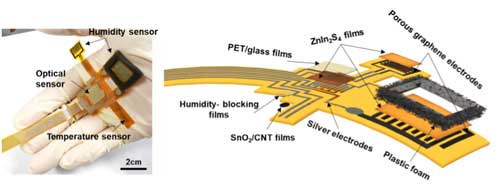| Aug 12, 2020 | |
Probing plant health status using flexible sensor systems |
|
| (Nanowerk Spotlight) The continuous increase of human population and environmental stresses increases the requirements for improving plant productivity and ecosystem balance. However, the emergence of biotic and abiotic stresses poses potential impairment on plant growth and yield. Accurate monitoring and assessment of plant health status thereby become high of importance, whereas conventional bulky and heavy sensors are usually restricted to access centralized climate conditions or perform measurement in gas exchange chambers. | |
| One strategy relies on intelligently interfacing plants with flexible sensors. However, it is challenging to tap into physiological information in plants due to their relatively complex signaling pathways. Additionally, synchronous detection of various abiotic stress factors demands a perdurable flexible multimodal sensor system for prolonged monitoring without performance degradation and signal cross-talk. | |
| In a recent study published in ACS Nano ("Multimodal Plant Healthcare Flexible Sensor System"), researchers from Osaka Prefecture University (OPU) report an integrated multimodal flexible sensor system comprising a room humidity sensor, a leaf humidity sensor, an optical sensor, and a temperature sensor that can tap into potential physiological health issues of plants. | |
| Significantly, dehydration conditions are visually recorded in a Pachira macrocarpa during long-term monitoring (>15 days) based on this plant-machine biointerface by leveraging the plant transpiration process. | |
| Using stacked ZnIn2S4 (ZIS) nanosheets as the kernel sensing media, the ZIS nanosheets-based flexible sensor can not only perceive light illumination at a fast response (∼4 ms), but also monitor the humidity with a perdurable steady performance. | |
| As the ZIS nanosheets are applied in humidity sensor for the first time, the team also carried out detailed theoretical and experimental investigations of the humidity sensing mechanism. | |
| The researchers measured in real time three primary abiotic stresses – i.e. humidity, light and temperature – that govern the transpiration of plants are measured without signal cross-coupling effect. | |
 |
|
| Photo of the multimodal flexible sensor system for plant heath monitoring (left) and schematic of the detailed device structures (right). (Image: Osaka Prefecture University) (click on image to enlarge) | |
| "Most of the flexible sensors have been applied to human health monitoring and/or human-machine interfaces, says Prof. Dae-Hyeong Kim, an international leader in the field of soft electronics. "The proposed concept of the multimodal flexible sensor system for plant health status monitoring may open up a pathway toward intelligent agriculture." | |
| Prof. Kuniharu Takei, the leader of this project, emphasized that "by rationally selecting the active sensing materials and electrodes, we have addressed the perdurable sensor performance for long-term tracking of abiotic stresses on plants as well as multichannel signals’ collection without crosstalk." | |
| Future tasks include further reducing the thickness and weight of flexible sensor systems, increasing sensor functionality in response to other biotic and abiotic stresses, and improving capabilities to decode plant chemical signals in spatio-temporal patterns. The influence of environmental gases, such as CO2, O2, or NOx, on the sensor output should be considered as well. | |
| This work was a close collaboration by a multidisciplinary team of researchers. The first author is Ms. Yuyao LU and co-first author is Dr. Kaichen XU. | |
|
Provided by Department of Physics and Electronics, Osaka Prefecture University as a Nanowerk exclusive
|
|
|
Become a Spotlight guest author! Join our large and growing group of guest contributors. Have you just published a scientific paper or have other exciting developments to share with the nanotechnology community? Here is how to publish on nanowerk.com. |
|
